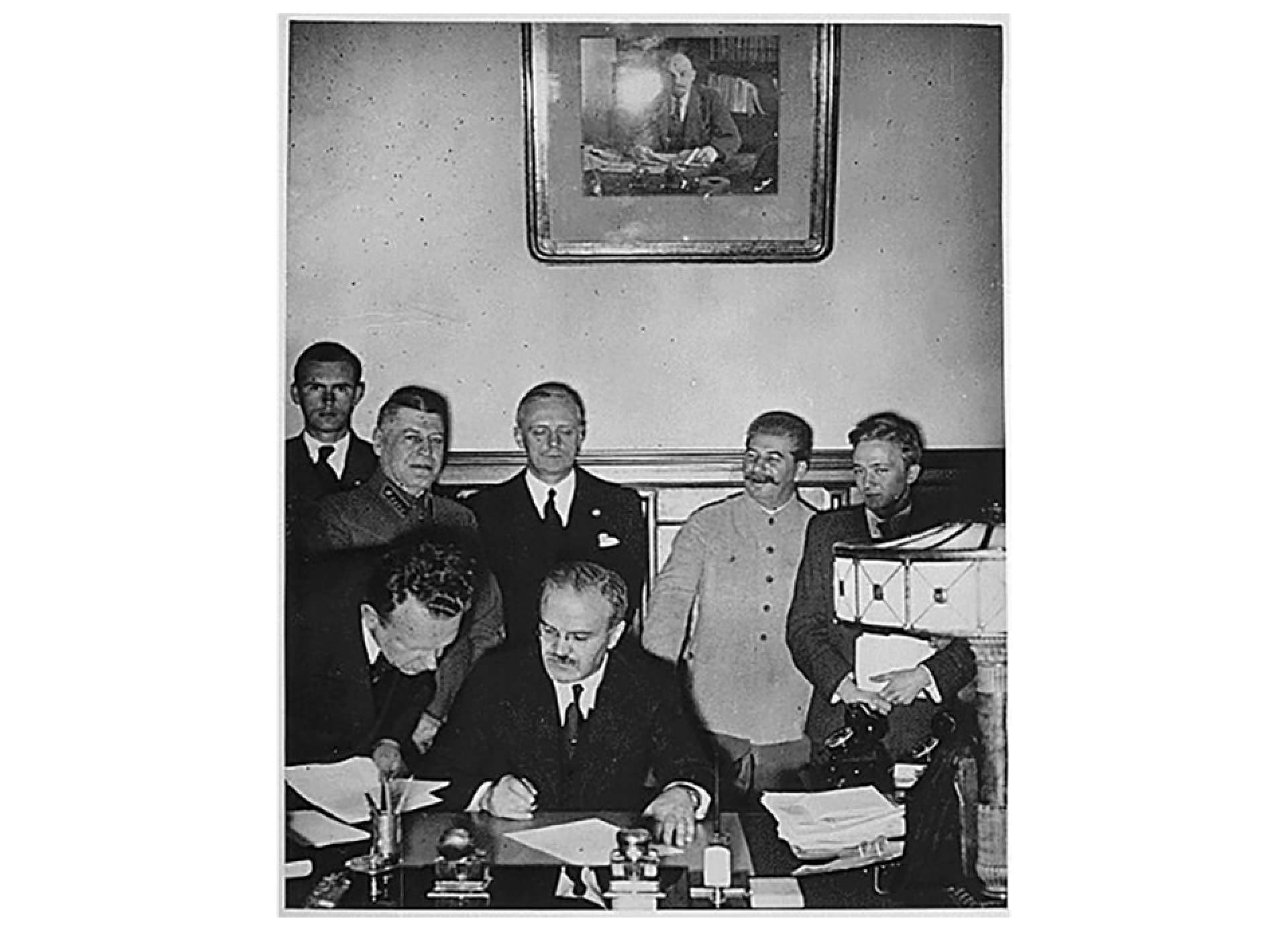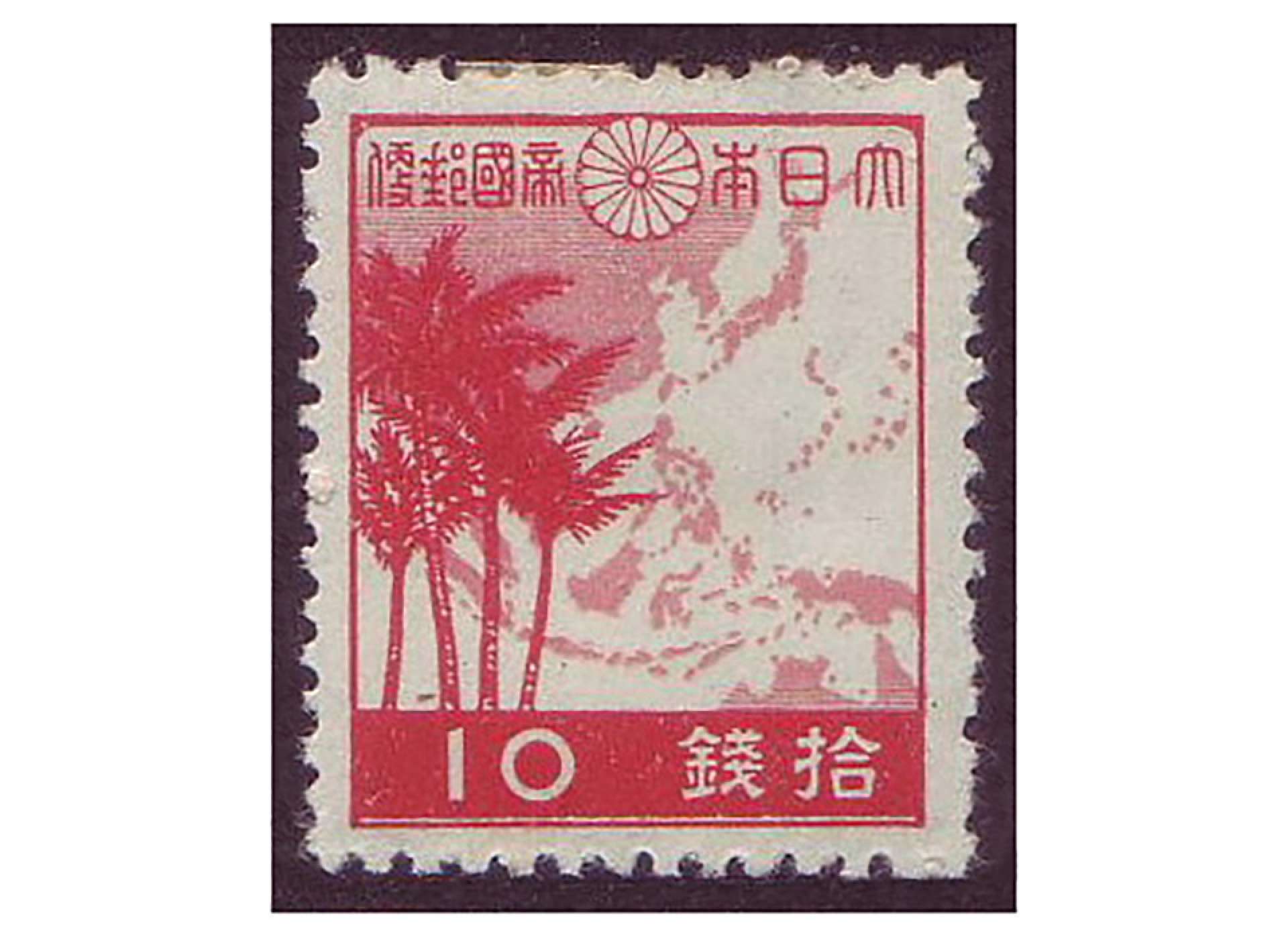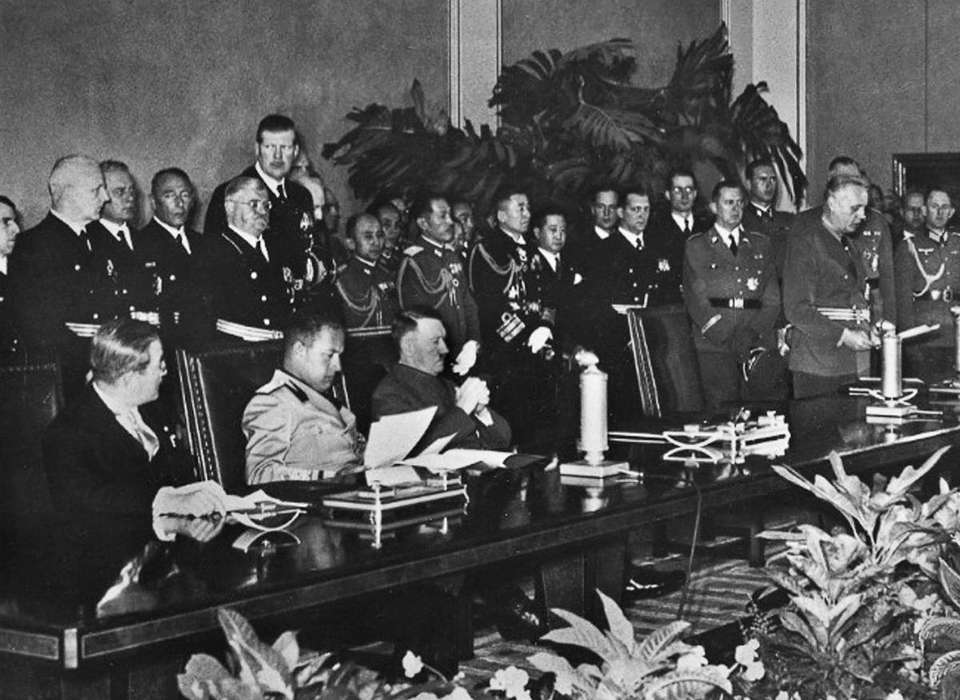Japanese Ambassador Saburō Kurusu, Count Galeazzo Ciano, Adolf Hitler, and German Foreign Minister Joachim von Ribbentrop at the Signing Ceremony for the Tripartite Pact, Berlin, September 27, 1940. Photo by Heinrich Hoffmann, courtesy of the National Archives.
Fits and starts. Fits and starts, that old idiom seems most useful for characterizing the course of German-Japanese relations following the 1936 Anti-Comintern Pact. Even though staunchly pro-German stalwarts existed in Japan as did their counterparts in the Nazi state, the two authoritarian regimes did not follow a linear path of collaboration into the war years.
As common ground, anti-communism and anti-Soviet fervor did not prove as stable as expected. For the next five years, as Imperial Japan and Nazi Germany fomented dreadful wars in Asia and Europe—to merge into a single global conflict in December 1941—shifting war aims and new entanglements dramatically complicated connections between the two powers. What eventually brought them together again in the early fall of 1940 to certify a new agreement was shared enmity toward Franklin D. Roosevelt’s United States of America.
This may appear jarring to readers. After all, in an earlier treatment of Hitler and the Third Reich’s ties with Japan, the United States hardly appeared. Britain, France, and the USSR presented the seemingly greatest obstacles to Japanese interests in East Asia and German intentions in Eastern Europe. Much changed, however, after Imperial Japan’s invasion of China in July 1937, especially during the summer of 1939.
The quagmire the Japanese Army found itself in in China worsened due to continuing and desperately needed Soviet aid to Chiang Kai-shek. Incursions by Japanese forces into the Mongolian People’s Republic, bordering China, then prompted Joseph Stalin to send troops to defend this Soviet client state. Border skirmishes with Japanese units took place on several occasions in 1938.
Consequently, in the fall of that year the Japanese Army and the Wehrmacht decided, as an extension of the Anti-Comintern Pact, to exchange military intelligence with one another regarding the USSR’s armed forces and explored ways of supporting anti-Soviet groups planning clandestine operations against the Stalin regime. At that time, hostility to the Soviet Union appeared a durable basis of cooperation for Germany and Japan alike.
Two events in 1939, though, threw this assumption into crisis, fundamentally transforming German-Japanese relations. The first involved confrontations between the Japanese Kwantung Army and the Red Army along the border between Manchuria, also known as the Japanese puppet state of Manchukuo, and Mongolia, capped by a decisive showdown in the summer of 1939. The latter, known as the Nomonhan Incident or Khalkhin-Gol Incident as the Soviets dubbed it, the Museum’s longtime friend, historian Rich Frank, characterizes as a “battle that rightly deserves ranking among the most important of World War II.”
A similar characterization was made by Richard Overy who defined it as a “full-scale border war” between the two nations. If memories of the Russo-Japanese War and Japan’s moves into Siberia during the Russian Civil War lingered, or Japanese overconfidence resulting from reports about Stalin’s purging of Marshal Tukhachevsky and other leading figures in the Red Army in 1937-38, they were quickly dispelled. No repetition of earlier triumphs occurred for the Japanese at Nomonhan/Khalkhin-Gol.
Due primarily to the leadership of General Georgi Zhukov, this clash ended in disaster for Japan in August 1939, with more than 8,600 killed and more than 9,000 wounded. To quote Rich Frank again, this defeat brutally demonstrated for the Japanese military that the
“doctrine created to offset Soviet numbers and material superiority by quick, relentless, offensive action by sparsely equipped foot soldiers had been tested and failed against a doctrine emphasizing combined arms and protracted warfare.”
Compounding the terrible results of the “Incident,” news of the August 1939 Nazi-Soviet Non-Aggression Pact, followed the next month by Germany’s partition of Poland with the Soviets, struck the Japanese government like thunderbolts. Here Foreign Minister Joachim von Ribbentrop once more cast a shadow far beyond his actual talents as a diplomat. This had to do with the firm support his obsequiousness, legendary even in the ranks of the Nazi Party, won from Hitler.
Appointed ambassador to Britain shortly before the signing of the Anti-Comintern Pact, Ribbentrop came to loathe the United Kingdom, deeming it Germany’s “greatest enemy,” all the while downplaying any threat of British counter-action to Hitler’s moves in Eastern Europe. After he became Foreign Minister in February 1938, Ribbentrop never missed an opportunity to ventriloquize his Führer’s imperialism.
Until World War II upended the Nazi dictatorship’s need for real diplomacy, Ribbentrop did understand how to play to Hitler’s undeniable boldness and confidence in himself as an instrument of Providence. In the summer of 1939, he pushed Hitler to consider a pact with Stalin in order to gain a free hand against Poland. The Non-Aggression Pact between Berlin and Moscow shocked much of the world, not least in Tokyo. Ribbentrop’s “success” in Moscow rendered the Anti-Comintern Pact a useless document.

Soviet Foreign Minister Vyacheslav Molotov signing the Nazi-Soviet Non-Aggression Pact, with Joseph Stalin and German Foreign Minister Joachim von Ribbentrop behind him, August 23, 1939. Image courtesy of the General Services Administration, National Archives, 540196.
The twin blows of Khalkhin-Gol, and the radical turn in German-Soviet affairs, produced swift consequences for Japanese politics. After only eight months in office, the short-lived Kiichirō Hiranuma government fell on August 30, 1939. Hiranuma, a fervent anti-communist, had feared that closer ties with Nazi Germany might drag Japan into a conflict with Britain and France it was not ready to fight. The events of the summer of 1939 pulled the proverbial rug out from under him. Following his resignation, Emperor Hirohito turned to General Nobuyuki Abe to replace him.
It was under Abe that Japan went to the negotiation table with Stalin in mid-September. Although Abe stayed in office for even less time than Hiranuma, Japanese political and military elites during the fall of 1939 drew a vital lesson from what had happened that summer: rely on diplomacy with Stalin and avoid war with the Red Army. This lesson held well into 1945. Abe also warned against calls within the Japanese Army to recultivate ties to Hitler and Fascist Italy.
For the next year, Imperial Japan primarily reacted to the actions of Germany, to its stunning conquests in Scandinavia and Western Europe in April-June 1940—and to those of the United States. If Germany’s string of victories opened up new possibilities for empire in Southeast Asia and the Pacific Ocean, with France humbled and Great Britain fighting for its life, this vastly different international situation raised, too, the specter of war with the United States.
While strong isolationist sentiment had constrained President Franklin D. Roosevelt’s ability to do much about Japanese aggression in China (even after the sinking of the gunboat, USS Panay, and three Standard Oil tankers on the Yangtze River in December 1937), such constraints began to lessen in 1940, as Germany seemed poised to invade the United Kingdom and Japan moved into northern Indochina in the summer of 1940. Foreign Minister Yōsuke Matsuoka’s proclamation of the Greater East Asia Co-Prosperity Sphere in early August only confirmed for the United States how dire things looked in both Europe and Asia.

Japanese stamp celebrating the expansion of the Greater East Asia Co-Prosperity Sphere, December 1942. Author Unknown.
A series of forceful American countermeasures left few doubts in Berlin and Tokyo that the Roosevelt Administration readied for intervention in World War II. In July 1940, Congress passed the Two Ocean Navy Act, a gigantic fleet-building program. That same year, Roosevelt ordered the Pacific Fleet to be moved from San Diego to Pearl Harbor on O’ahu in the US territory of the Hawaiian Islands, drastically extending the American defensive perimeter westward.
In September 1940, Washington both implemented a one-year draft and devised the Destroyers-for-Bases arrangement with Winston Churchill’s government. Roosevelt also increased support for Chiang, whose 1939-40 winter offensive instilled a stark realization in Japanese ruling circles that Nationalist China’s defeat was hardly a foregone conclusion.
For Hitler and for the government of Prince Fumimaro Konoe, the signs were unmistakable. Ribbentrop’s aide, Heinrich Stahmer (later the Third Reich’s ambassador to Japan), was dispatched to Japan. Stahmer read the mood of Japanese policy-makers. He understood that strong anti-British sentiment prevailed in the Japanese Army but that there was great reluctance to risk war with the Americans.
Could Roosevelt be deterred from intervening, could he be compelled to back down, by a show of unity of the fascist and militarist states? It was this line of thinking which informed the decision to bind the Axis countries more closely together.
With pomp and circumstance, Hitler, Imperial Japan’s Ambassador to Germany, Saburō Kurusu (later a central figure in diplomatic talks between Japan and the United States prior to Pearl Harbor), and Count Galeazzo Ciano, Mussolini’s son-in-law, gathered in Berlin. On September 27, 1940, they signed the Tripartite Pact.
A 10-year deal between the three, the Pact called for each country to offer military, political, and economic assistance if a signatory was attacked by “a Power at present not involved in the European or in the Sino-Japanese Conflict.” One did not have to spend much time ruminating about which nation was the referent—a still neutral United States of America. In other words, this was, on paper, a defensive alliance designed to check American power. Yet no clear-thinking individual could trust any of these abhorrent regimes to maintain a “defensive” stance on anything.
The Roosevelt Administration, the US press, and the American public immediately took note. As 1940 concluded, conflict between the United States and the Tripartite Pact looked increasingly inevitable.
Recommended Reading
Frank, Richard B. Tower of Skulls: A History of the Asia-Pacific War, July 1937-May 1942. New York: W.W. Norton & Company, 2020.
Overy, Richard. Russia’s War: A History of the Soviet War Effort: 1941-1945. London: Penguin Books, 1997.
Weinberg, Gerhard. A World at Arms: A Global History of World War II. 2nd Edition. Cambridge: Cambridge University Press, 2005.
Jason Dawsey, PhD
Jason Dawsey, PhD, is ASU WWII Studies Consultant in the Jenny Craig Institute for the Study of War and Democracy.
Cite this article:
MLA Citation:
APA Citation:
Chicago Style Citation:






![Max Fuchs, New York City cantor, sings as Rabbi Sydney [sic] Lefkowitz, Richmond, VA, conducts the first Jewish services from Germany.](/sites/default/files/styles/max_650x650/public/2025-10/image1.jpg)


